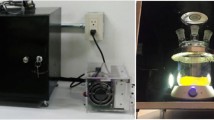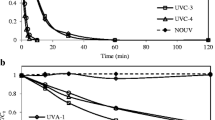Abstract
Diclofenac (DCF) photocatalytic degradation with TiO2-P25 illuminated with UV-A light in aqueous media was investigated. The photodegradation rate was assessed by HPLC and UV–vis spectroscopy, while the mineralization rate was obtained by total organic carbon measurements. The formation and degradation of intermediate compounds were investigated by UV–vis, IR and 1H NMR spectroscopy and GC/MS analysis. UV–vis absorbance and HPLC results indicated that DCF is completely transformed into some aromatic compounds after several hours of irradiation. TOC analysis indicated that some intermediate compounds are degraded slowly since 90% mineralization was achieved after several hours of irradiation. FT-IR studies demonstrated a rapid conversion of diclofenac into a lactam, which was converted into several aromatic compounds. GC/MS and HPLC analysis indicated that the initial photoproducts are two lactams and several aromatic anilines and phenols. 1H NMR studies indicated DCF degrades by a rather simple mechanism generating a recalcitrant intermediate acid, namely 2-hydrophenyl acetic acid which is oxidized in several steps by hydroxyl radicals. 1H NMR studies also indicated that an oxidation route via a quinone is actually a very minor pathway. Based on this and previous investigations, a total photocatalytic degradation mechanism for DCF is presented, first involving hydroxyl radical reactions to generate anilines and phenols, which were all converted into polyhydroxylated compounds and eventually into low molecular saturated and unsaturated amines and carboxylic acids. Basic studies about diclofenac photocatalytic degradation are required for future applications of this process in the removal of DCF and other structurally related pharmaceutical compounds from any water body.
Graphic Abstract


















Similar content being viewed by others
References
Leyva E, Moctezuma E, Baines KM, Noriega S, Zarazúa E (2018) A review on chemical advanced oxidation processes for pharmaceuticals with paracetamol as a model compound. reaction conditions, intermediates and total mechanism. Curr Org Chem 22:2–17
Leyva E, Moctezuma E, Lopez M, Baines KM, Zermeño B (2019) Photocatalytic degradation of beta-blockers in TiO2 with metoprolol as model compound. Intermediates and total reaction mechanism. Catal Today 323:14–25
Dong SY, Feng JL, Fan MH, Pi YQ, Hu LM, Han X, Liu ML, Sun JY, Sun JH (2015) Recent developments in heterogeneous photocatalytic water treatment using visible light-responsive photocatalysts: a review. RSC Adv 5:14610–14630
Lee CM, Palaniandy P, Dahlan I (2017) Pharmaceutical residues in aquatic environment and water remediation by TiO2 heterogeneous photocatalysis: a review. Environ Earth Sci 76:611–620
Tong AYC, Braund R, Warren DS, Peake BM (2012) TiO2-assisted photodegradation of pharmaceuticals—a review. Cent Eur J Chem 10:989–1027
Augugliaro V, Litter M, Palmisano L, Soria J (2006) The combination of heterogeneous photocatalysis with chemical and physical operations: a tool for improving the photoprocess performance. J Photochem Photobiol C: Rev 7:127–144
Bagal MV, Gogate PR (2014) Degradation of diclofenac sodium using combined processes based on hydrodynamic cavitation and heterogeneous photocatalysis. Ultrason Sonochem 21:1035–1043
Beltrán FJ, Aguinaco A, García-Araya JF (2010) Kinetic modelling of TOC removal in the photocatalytic ozonation of diclofenac aqueous solutions. Appl Catal B Environ 100:289–298
García-Araya JF, Beltrán FJ, Aguinaco A (2010) Diclofenac removal from water by ozone and photolytic TiO2 catalysed processes. J Chem Technol Biotechnol 85:798–804
Méndez-Arriaga F, Torres-Palma RA, Pétrier C, Esplugas S, Gimenez J, Pulgarin C (2009) Mineralization enhancement of a recalcitrant pharmaceutical pollutant in water by advanced oxidation hybrid processes. Water Res 43:3984–3991
Perisic DJ, Gilja V, Stankov MN, Katancic Z, Kusic H, Stangar UL, Dionysiou DD, Bozic AL (2016) Removal of diclofenac from water by zeolite-assisted advanced oxidation processes. J Photochem Photobiol A Chem 321:238–247
Bonnefille B, Gomez E, Courant F, Escande A, Fenet H (2018) Diclofenac in the marine environment: a review of its occurrence and effects. Marine Pollut Bull 131:496–506
Félix-Cañedo TE, Durán-Álvarez JC, Jiménez-Cisneros B (2013) The occurrence and distribution of a group of organic micropollutants in Mexico City’s water sources. Sci Total Environ 454:109–118
Acuña V, Ginebreda A, Mor JR, Petrovic M, Sabater S, Sumpter J, Barceló D (2015) Balancing the health benefits and environmental risks of pharmaceuticals: diclofenac as an example. Environ Int 85:327–333
Pérez-Álvarez I, Islas-Flores H, Gómez-Oliván LM, Barceló D, López De Alda M, Pérez-Solsona S, Sánchez-Aceves L, SanJuan-Reyes N, Galar-Martínez M (2018) Determination of metals and pharmaceutical compounds released in hospital wastewater from Toluca, Mexico, and evaluation of their toxic impact. Environ Pollut 240:330–341
Schwarz S, Schmieg H, Scheurer M, Köhler HR, Triebskorn R (2017) Impact of the NSAID diclofenac on survival, development, behaviour and health of embryonic and juvenile stages of brown trout, Salmo trutta f. fario. Sci Total Environ 607:1026–1036
Chen P, Zhang QX, Su YH, Shen LZ, Wang FL, Liu HJ, Liu Y, Cai ZW, Lv WY, Liu GG (2018) Accelerated photocatalytic degradation of diclofenac by a novel CQDs/BiOCOOH hybrid material under visible-light irradiation: dechloridation, detoxicity, and a new superoxide radical model study. Chem Eng J 332:737–748
Aziz KHH, Miessner H, Mueller S, Kalass D, Moeller D, Khorshid I, Rashid MAM (2017) Degradation of pharmaceutical diclofenac and ibuprofen in aqueous solution, a direct comparison of ozonation, photocatalysis, and non-thermal plasma. Chem Eng J 313:1033–1041
Kanakaraju D, Motti CA, Glass BD, Oelgemoller M (2016) Solar photolysis versus TiO2-mediated solar photocatalysis: a kinetic study of the degradation of naproxen and diclofenac in various water matrices. Environ Sci Pollut R 23:17437–17448
Moreira NFF, Orge CA, Ribeiro AR, Faria JL, Nunes OC, Pereira MFR, Silva AMT (2015) Fast mineralization and detoxification of amoxicillin and diclofenac by photocatalytic ozonation and application to an urban wastewater. Water Res 87:87–96
Czech B, Buda W (2016) Multicomponent nanocomposites for elimination of diclofenac in water based on an amorphous TiO2 active in various light sources. J Photochem Photobiol A Chem 330:64–70
Das L, Barodia SK, Sengupta S, Basu JK (2015) Aqueous degradation kinetics of pharmaceutical drug diclofenac by photocatalysis using nanostructured titania-zirconia composite catalyst. Int J Environ Sci Technol 12:317–326
Shi JW, Wang ZY, He C, Wang HK, Chen JW, Fu ML, Li GD, Niu CM (2015) CdS quantum dots modified N-doped titania plates for the photocatalytic mineralization of diclofenac in water under visible light irradiation. J Mol Catal A Chem 399:79–85
Zhang W, Zhou L, Deng HP (2016) Ag modified g-C3N4 composites with enhanced visible-light photocatalytic activity for diclofenac degradation. J Mol Catal A Chem 423:270–276
Achilleos A, Hapeshi E, Xekoukoulotakis NP, Mantzavinos D, Fatta-Kassinos D (2010) Factors affecting diclofenac decomposition in water by UV-A/TiO2 photocatalysis. Chem Eng J 161:53–59
Alawi MA, Alahmad W (2010) Kinetic study of photocatalytic degradation of several pharmaceuticals assisted by SiO2/TiO2 catalyst in solar bath system. Jordan J Pharm Sci 3:126–136
da Cruz LH, Henning FG, dos Santos AB, Peralta-Zamora P (2010) Degradação fotocatalítica de sulfametoxazol, trimetoprima e diclofenaco em solução aquosa. Quim Nova 33:1270–1274
Kanakaraju D, Glass BD, Oelgemoller M (2014) Titanium dioxide photocatalysis for pharmaceutical wastewater treatment. Environ Chem Lett 12:27–47
Miranda-García N, Suárez S, Sánchez B, Coronado JM, Malato S, Maldonado MI (2011) Photocatalytic degradation of emerging contaminants in municipal wastewater treatment plant effluents using immobilized TiO2 in a solar pilot plant. Appl Catal B Environ 103:294–301
Sarasidis VC, Plakas KV, Patsios SI, Karabelas AJ (2014) Investigation of diclofenac degradation in a continuous photo-catalytic membrane reactor. Influence of operating parameters. Chem Eng J 239:299–311
Perišić DJ, Belet A, Kušić H, Štangar UL, Božić AL (2017) Comparative study on photocatalytic treatment of diclofenac: slurry vs. immobilized processes. Desalin Water Treat 81:170–185
Agüera A, Pérez-Estrada LA, Ferrer I, Thurman EM, Malato S, Fernández-Alba AR (2005) Application of time-of-flight mass spectrometry to the analysis of phototransformation products of diclofenac in water under natural sunlight. J Mass Spectrom 40:908–915
Martínez C, Canle M, Fernández MI, Santaballa JA, Faria J (2011) Aqueous degradation of diclofenac by heterogeneous photocatalysis using nanostructured materials. Appl Catal B Environ 107:110–118
Yu H, Nie E, Xu J, Yan SW, Cooper WJ, Song WH (2013) Degradation of diclofenac by advanced oxidation and reduction processes: kinetic studies, degradation pathways and toxicity assessments. Water Res 47:1909–1918
Calza P, Sakkas VA, Medana C, Baiocchi C, Dimou A, Pelizzetti E, Albanis T (2006) Photocatalytic degradation study of diclofenac over aqueous TiO2 suspensions. Appl Catal B Environ 67:197–205
Moctezuma E, Leyva E, Lopez M, Pinedo A, Zermeño B, Serrano B (2013) Photocatalytic degradation of metoprolol tartrate. Top Catal 56:1875–1882
Lara-Pérez MC (2018) Photocatalytic degradation of diclofenac. MSc Thesis, University of San Luis Potosí
Leyva E, Lara-Pérez C, Zermeño B, Osorio I, Moctezuma E Photocatalytic degradation of diclofenac sodium salt: adsorption and reaction kinetic studies. Environ Earth Sci (Submitted)
Pavia DL, Lampman GM, Kriz GS, Vyvyan JR (2013) Introduction to spectroscopy. Cengage Learning, Belmont
Palomo ME, Ballesteros MP, Frutos P (1999) Analysis of diclofenac sodium and derivatives. J Pharm Biomed Anal 21:83–94
Manca ML, Zaru M, Ennas G, Valenti D, Sinico C, Loy G, Fadda AM (2005) Diclofenac-beta-cyclodextrin binary systems: physicochemical characterization and in vitro dissolution and diffusion studies. AAPS Pharm Sci Tech 6:E464–E471
Yang D, Fu H (2010) A simple and practical copper-catalyzed approach to substituted phenols from aryl halides by using water as the solvent. Chem Eur J 16:2366–2370
Corey EJ, Czakó B, Kürti L (2007) Molecules and medicine. Wiley, Hoboken
Li XJ, Cubbage JW, Tetzlaff TA, Jenks WS (1999) Photocatalytic degradation of 4-chlorophenol. 1. The hydroquinone pathway. J Org Chem 64:8509–8524
Li XJ, Cubbage JW, Jenks WS (1999) Photocatalytic degradation of 4-chlorophenol. 2. The 4-chlorocatechol pathway. J Org Chem 64:8525–8536
Ryu J, Choi W (2008) Substrate-specific photocatalytic activities of TiO2 and multiactivity test for water treatment application. Environ Sci Technol 42:294–300
Sauer T, Neto GC, José HJ, Moreira R (2002) Kinetics of photocatalytic degradation of reactive dyes in a TiO2 slurry reactor. J Photochem Photobiol A Chem 149:147–154
Pérez-Estrada LA, Maldonado MI, Gernjak W, Agüera A, Fernández-Alba AR, Ballesteros MM, Malato S (2005) Decomposition of diclofenac by solar driven photocatalysis at pilot plant scale. Catal Today 101:219–226
Bekkouche S, Bouhelassa M, Salah NH, Meghlaoui FZ (2004) Study of adsorption of phenol on titanium oxide (TiO2). Desalination 166:355–362
de Lasa H, Serrano B, Salaices M (2005) Photocatalytic reaction engineering. Springer, New York
Moctezuma E, Leyva E, Aguilar CA, Luna RA, Montalvo C (2012) Photocatalytic degradation of paracetamol: intermediates and total reaction mechanism. J Hazard Mater 243:130–138
Acknowledgements
This work was supported by Consejo Nacional de Ciencia y Tecnología—México [Grants PDCPN-2014–01-248692 and CB-256795–2015] and Universidad Autónoma de San Luis Potosí—México [Grant C17-FRC-04–06.06].
Author information
Authors and Affiliations
Corresponding author
Additional information
Publisher's Note
Springer Nature remains neutral with regard to jurisdictional claims in published maps and institutional affiliations.
Rights and permissions
About this article
Cite this article
Moctezuma, E., Leyva, E., Lara-Pérez, C. et al. TiO2 Photocatalytic Degradation of Diclofenac: Intermediates and Total Reaction Mechanism. Top Catal 63, 601–615 (2020). https://doi.org/10.1007/s11244-020-01262-7
Published:
Issue Date:
DOI: https://doi.org/10.1007/s11244-020-01262-7




